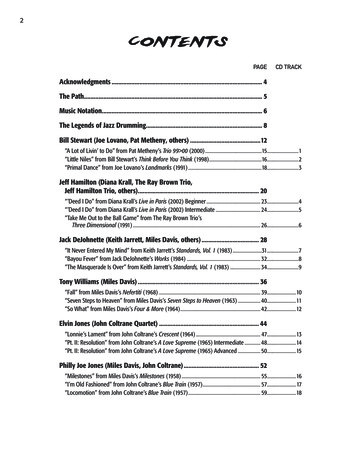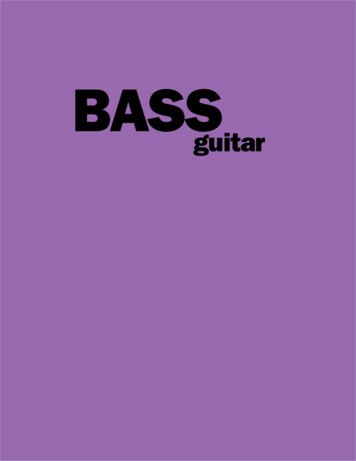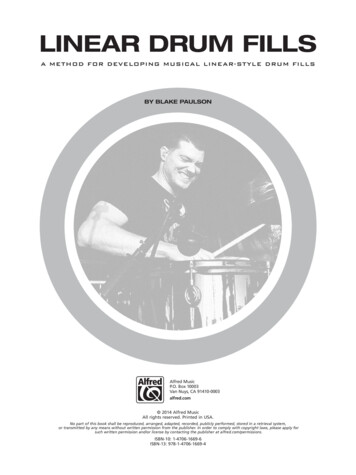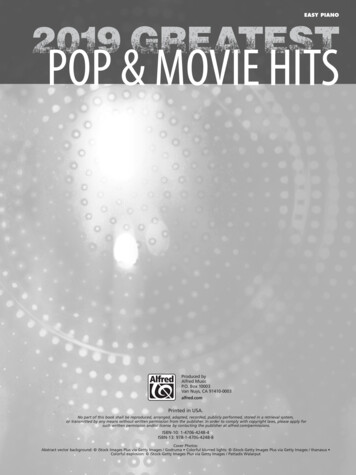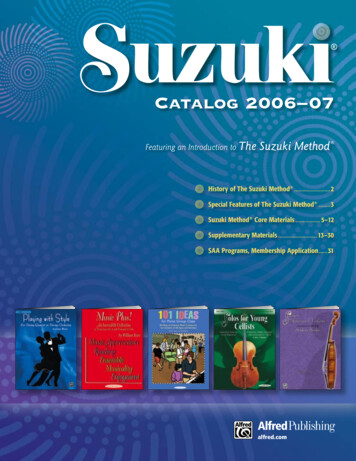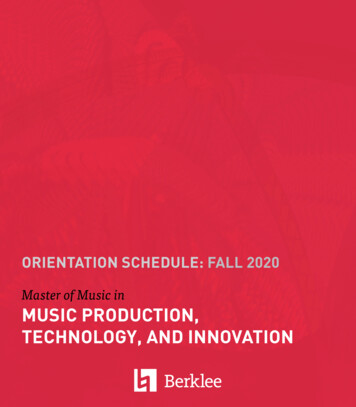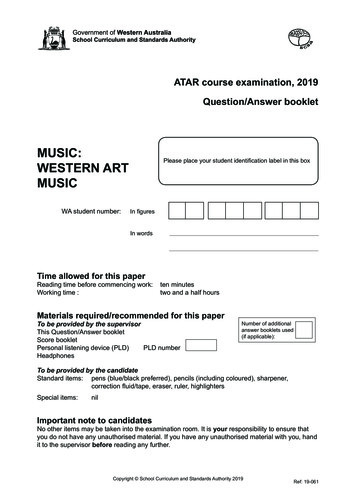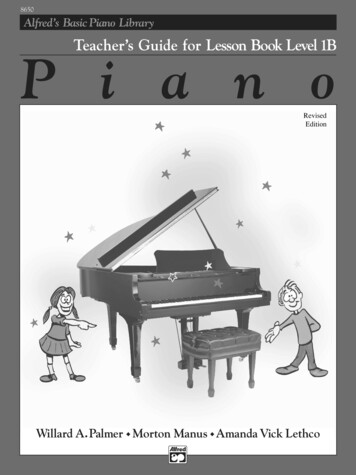
Transcription
Alfred’s Basic Piano LibraryTEACHER’S GUIDEto Lesson Book 1BPURPOSE To suggest an order of lesson activitiesthat will result in a systematic and logicalpresentation of the material in Lesson Book, Level 1Bof ALFRED’S BASIC PIANO LIBRARY. It gives theteacher considerable flexibility and is in no wayintended to restrict the lesson procedures.PRESENTATION This Guide is basically presentedin outline form. The relative importance of eachactivity is reflected in the words used to introduceeach portion of the outline, such as EMPHASIZE,SUGGESTION, IMPORTANT, OPTIONAL, etc. Whilesuch words are used to indicate the authors’ judgmentas to the significance of each item, everything in thebook should fall into the category of suggestedprocedures. The teacher’s discretion will apply ineach individual situation. Each page in this Guide isnumbered identically with Lesson Book 1B for easyreference.PROBLEM-FREE PROGRESS To avoid GAPS thatwould impede progress, the authors have usedOVERLAPPING CONCEPTS throughout the course.(After a concept has been introduced, it continues tobe reinforced simultaneously with the introduction ofnew concepts — overlapping concepts.)INTERVAL READING Continued reading byintervals is stressed in Lesson Book 1B. The piecesare very appealing and provide much motivation forstudents to move forward in the book.INTERACTION On almost every page, there arecomments leading to “Interaction” between theteacher and student. Such interaction is valuable tothe teacher in ascertaining whether specific conceptsactually have been learned. Interaction is valuable tothe student because such focused discussion anddemonstration leads to quicker and more lastingmusical development. If the student is insecure withconcepts, the teacher may wish to review them. Theteacher is especially urged to assign Alfred’s BasicFlash Cards, along with the pages of Theory Book 1Band Recital Book 1B as they are recommended in thisGuide. These materials strongly reinforce everymusical principle introduced in the Lesson Book andprovide attractive additional opportunities forlearning theory and building repertoire.IMPORTANCE OF SUPPLEMENTARYMATERIALS Other important materials that arecarefully coordinated with Lesson Book 1B includethe following: Composition Book 1B, Duet Book 1B,Ear Training Book 1B, Ensemble Book 1B, Fun Book1B, Graduation Book 1B, Hymn Book 1B, Jazz/RockCourse 1, Merry Christmas! Book 1B, NotespellerBook 1B, Sight Reading Book 1B, Theory Through theYear 1B, Top Hits! Christmas Book 1B, Top Hits! DuetBook 1B, Top Hits! Solo Book 1B and Theory SoftwareGames for Windows and Macintosh computers. Anumber of solos are also published that fit perfectlywith Level 1B.ASSIGNMENTS The suggested assignments remindthe teacher of all of the coordinated materials that fitperfectly with each page of Lesson Book 1B. Theteacher can select as much or as little of thesuggested material as seems appropriate for eachindividual student. This precisely graded material isdesigned to enrich the student’s musical experiencewhen introduced as suggested.MUSICAL GROWTH By the end of Lesson Book 1Bof ALFRED’S BASIC PIANO LIBRARY, the studentwill have a broad base of musical skills and conceptsthat will be developed further in subsequent books.The student learns something new on practicallyevery page, and the new concepts are constantlyreinforced and reviewed. The use of thesupplementary materials mentioned above willprovide additional reinforcement, and students willenjoy playing a variety of pieces well suited to theirneeds and abilities. It is good to remind students thatthey are constantly making progress as they movethrough the books. Sincere praise from the teacher isone of the most motivating factors in teaching piano.Praise rather than admonish.RECORDINGS A compact disc and a General MIDIdisk are available. Both include a full piano recordingand orchestrated background accompaniment. Theuse of these recordings will aid the student inchoosing appropriate tempos and playing correctrhythms from the very beginning. In addition, therecordings reinforce the important concepts thatconstitute good musicianship. The recordings can beused in the lesson as a reward for learning the pieceor at home to encourage practice.The authors hope that this Teacher’s Guide willprovide a source that is useful in planning eachlesson, and that the results will be beneficial forteachers and students alike.WILLARD A. PALMER, MORTON MANUS,AMANDA VICK LETHCOCopyright MCMXCIX by Alfred Publishing Co., Inc.All rights reserved. Printed in USA.ISBN 0-7390-0864-1
2REVIEWOVERLAPPING CONCEPTSFROM LESSON BOOK 1AThe entire page.GOALReview of concepts learned by students whohave successfully completed Level 1A ofAlfred’s Basic Piano Library.IMPORTANTLesson Book 1B may also be used as the firstbook for students who have had some priormusical experience, but have not had pianolessons. This is also an excellent book tostart transfer students. The first 15 pagesare a complete review of everythingintroduced in Lesson Book 1A. Teach thesepages quickly if the student understands allconcepts. However, it may be necessary toemphasize specific concepts the studentneeds to review.EMPHASIZECONCEPTS REVIEWED Grand StaffEach of the concepts reviewed is essential to readingand playing. Brace Bass ClefINTERACTION Treble ClefStudents use page 3 to point out each elementreviewed on page 2, with the exception of quarter andhalf rests. They may point out the quarter rest andthe half rest on page 2, explaining each rest. Measure Bar Lines Double Bar Relationship of notes on the staff to the keyson the keyboardSUGGESTED ASSIGNMENTS Dynamic signs Pages 2–3 of Theory Book 1B.F (mezzo forte)4 4 Time Signature Note Values: q (count 1), h (count 2), w (count 4) -Ó Rest Values: Œ Page 3 of Notespeller Book 1B.
3GENERALCD 2GM 1 (43)*REVIEWC PositionOVERLAPPING CONCEPTSStudent has used page 3 to point outelements reviewed on page 2. Thisinteraction assures success when the studentplays page 3.GOALTo play comfortably and correctly inC position, including the following: Playing and saying letter names of notesin C position.q h and w rhythms Clapping (or tapping) ,in “Step Right Up!” Playing and counting out loud. Playing and singing the words. Observing tempo mark: Moderately slow. Observing (repeat sign).EMPHASIZESUGGESTED ASSIGNMENTSSteady rhythm Page 3 of Ear Training Book 1B. Page 4 of Notespeller Book 1B.SUGGESTION Page 4 of Theory Book 1B.REMIND STUDENT: to play with rounded hand, tocount aloud, to keep eyes on the music and to listen! Page 3 of Theory Through the Year Book 1B.INTERACTION Student points to and explains and Then student points to notes in “Step Right Up!”and names each note. Student points to and explains Student plays notes that match “step right” andexplains that “step right” goes up the keyboard.Student plays notes that match “step left” andexplains that “step left” goes down the keyboard.*Next to the CD icon is the corresponding CD tracknumber. Next to the GM icon is the correspondingType 0 file number and, in parentheses, the Type 1file number.
4GENERALCD 3GM 2 (44)REVIEWC position review of Melodic Intervals: 2nds,3rds, 4ths and 5thsOVERLAPPING CONCEPTS44 time signature F Ó GOALPreparation to assure success in playing themelodic intervals found in “The Carousel.”EMPHASIZE Melodic 2nds move from a line to the nextspace or from a space to the next line. Melodic 3rds move from a line to the nextline or from a space to the next space. Melodic 4ths move from a line to a space,skipping a line. They may also move froma space to a line, skipping a space. Melodic 5ths move from a line to a line, skipping aline. They may also move from a space to a space,skipping a space.INTERACTIONStudent names all melodic intervals in “TheCarousel.” Student says note names of each note in“The Carousel.”SUGGESTED ASSIGNMENTS Page 4 of Ear Training Book 1B. Page 5 of Notespeller Book 1B. Page 2 of Sight Reading Book 1B. Page 5 of Theory Book 1B. Page 4 of Theory Through the Year Book 1B.
5GENERALCD 4 & 5GM 3 (45) & 4 (46)REVIEW Legato play smoothly connected Slur the indication to play legato Slurs often divide music into phrases Phrases musical thoughts Dynamics:p (piano) softf (forte) loudOVERLAPPING CONCEPTS 44 time signature C PositionF -Ó Œ GOALS To play legato. To observep and f dynamic indications. To observe whole rests, half rests andquarter rests EXACTLY. in “Hail to Thee, America!” and in To observe“Brother John.”INTERACTION Student points to and explains how to observe slurson page 5. Student points to and explains meaning of alldynamic markings on page 5. Student points to and defines all rests on page 5. Student points to and defines Student names intervals on page 5. Student says letter names of notes on page 5.SUGGESTED ASSIGNMENTS Page 2 of Composition Book 1B. Page 5 of Ear Training Book 1B. Begin Group 1 Exercises of Technic Book 1B. Pages 6–7 of Theory Book 1B.
6GENERALCD 6GM 5 (47)REVIEWNotes played together make HARMONY.Intervals between these notes are calledHarmonic Intervals:Harmonic 2ndsHarmonic 3rdsHarmonic 4thsHarmonic 5thsOVERLAPPING CONCEPTS 44 time signature C PositionF Ó GOALTo learn fluent response in playingharmonic intervals.IMPORTANTThe words to “Good Sounds” reinforce and definethe HARMONIC INTERVAL being played.SUGGESTED ASSIGNMENTS Page 3 of Composition Book 1B. Page 6 of Ear Training Book 1B.CONTINUING Page 6 of Notespeller Book 1B.This piece may also be used to encourage ear training.The student recognizes 2nds, 3rds, 4ths and 5thswhen heard because of singing the words to “GoodSounds.” Pages 2–3 of Recital Book 1B. Page 3 of Sight Reading Book 1B. Page 8 of Theory Book 1B. Page 5 of Theory Through the Year Book 1B.INTERACTION Student plays random 2nds, 3rds, 4ths and 5ths onthe keyboard. Student names intervals in measures 3, 4, 7 and 8of “Good Sounds.”
7GENERALCD 7GM 6 (48)REVIEW43 Time Signature h. OVERLAPPING CONCEPTS 44 time signature C Position F Harmonic Intervals: 2nds, 3rds,4ths and 5ths Slurs GOALS Fluent response to harmonic intervals inthe left hand while playing melodicintervals in the right hand. Understanding43time signature. Rhythmic security onpatternsh q \ q q q \ h. \SUGGESTED ASSIGNMENTSINTERACTION Student defines43 Page 4 of Composition Book 1B.time signature. Student points to eachcounts aloud “1-2-3.”h . in “The Cuckoo” and Page 7 of Ear Training Book 1B. Pages 2–3 of Hymn Book 1B. Pages 4–5 of Recital Book 1B. Student plays the left hand of “The Cuckoo” aloneand names each HARMONlC INTERVAL. Page 4 of Sight Reading Book 1B. Student plays right hand alone and names eachMELODIC INTERVAL.A second piano part for this piece is contained in thebook Second Piano Parts for Selected Pieces fromLesson Books 1B and 2 (#18120) on page 2. Student traces slurs with a finger and definesmeaning of slur.
8GENERALCD 8GM 7 (49)REVIEWThe Sharp SignOVERLAPPING CONCEPTS 44 time signature Dynamic contrast by exact observance ofand indicationsfp Left hand harmonic intervals Right hand melodic intervals Exact observance of-ÓGOALS Recognition of sharps. Playing the 4 sharped notes in“Money Can’t Buy Everything.” Fun!REMEMBERWhen a sharp sign appears before a note, itapplies to that note for the rest of themeasure.SUGGESTED ASSIGNMENTSINTERACTION Pages 2–3 and 4–5 of Duet Book 1B. Student draws several sharps at top of page 8.(Remind student that sharps look a lot like atic-tac-toe diagram.) Page 8 of Ear Training Book 1B. Student defines sharps: “Next key to the right,whether black or white.” (Teacher emphasizes thatthe definition makes a rhyme.) Student plays and names random sharpson the keyboard. Student plays “Money Can’t Buy Everything”while singing the words with the teacher. Pages 2–5 of Ensemble Book 1B. Flash Cards 69 and 70. Page 2 of Fun Book 1B. Page 7 of Notespeller Book 1B. Pages 6–7 of Recital Book 1B. Page 5 of Sight Reading Book 1B. Begin Group 2 Exercises of Technic Book 1B. Page 9 of Theory Book 1B.A second piano part for this piece is contained in thebook Second Piano Parts for Selected Pieces fromLesson Books 1B and 2 (#18120) on page 3.
9GENERALCD 9GM 8 (50)REVIEWStaccatoOVERLAPPING CONCEPTS44 time signature F and f Œ and Harmonic 2ndGOALReview of staccato articulation.INTERACTIONq Student draws several ’s at top of page 9,and places a dot over or under each toindicate staccato. Student defines staccato: “separated ordetached notes.” Student plays several random staccatonotes on the keyboard. Student names harmonic intervals in RHof “Ping-Pong.” Student names letter names of each notein “Ping-Pong.”SUGGESTED ASSIGNMENTS Page 4 of Duet Book 1B. Page 9 of Ear Training Book 1B. Page 8 of Notespeller Book 1B. Page 6 of Sight Reading Book 1B. Page 10 of Theory Book lB. Page 6 of Theory Through the Year Book 1B.
10GENERALCD 10GM 9 (51)REVIEWIncomplete MeasureUpbeat incomplete measure.Downbeat first beat of the measure whichfollows the upbeat. A downbeat is the firstbeat of any measure.OVERLAPPING CONCEPTS44 time signature p and F Staccato Œ - -Ó LH harmonic intervals RH melodic intervals GOALS Exact observance of the overlappingconcepts. Understanding of incomplete measure atthe beginning of the piece.PRACTICESUGGESTED ASSIGNMENTS Page 5 of Composition Book 1B.SUGGESTION Page 10 of Ear Training Book 1B.Student plays the incomplete measure very quietlybecause it is an upbeat, which leads towards astronger downbeat. Page 3 of Fun Book 1B. Pages 8–9 of Recital Book 1B with page 10 or 11. Page 7 of Sight Reading Book 1B.INTERACTIONStudent counts last measure out loud plus theincomplete measure at the beginning of the piece,thus understanding that the sum of the last measureplus the first measure equals four beats. Four beatsis equal to one full measure of when the pie
Alfred’s Basic Piano Library. IMPORTANT Lesson Book 1B may also be used as the first book for students who have had some prior musical experience, but have not had piano lessons. This is also an excellent book to start transfer students. The first 15 pages are a complete review of everything introduced in Lesson Book 1A. Teach these pages quickly if the student understands all concepts .

